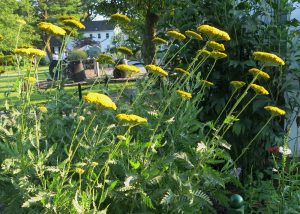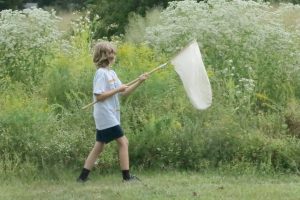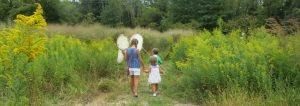
What better way to discover the intriguing world of bugs than to head out there and experience them for yourself? (Photo by Betty Scarlata)
Now’s a great time to celebrate all the flying, hopping, swimming, creeping, crawling, and utterly fascinating insects that share our world…
What’s the buzz? If you are among those who think bugs are as at best annoyances and at worst things to be eradicated from your yard, you may be surprised to learn that insects of all sorts play a huge role in our world. In fact, there are more types of insects on our planet than any other kind of animal! And while a small percentage are considered harmful to humans or property, the vast majority of insects are highly beneficial to people, gardens and the environment at large.
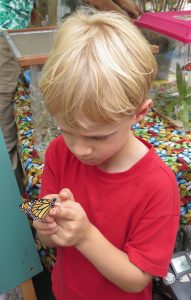
More than just beautiful, butterflies help pollinate flowers and their caterpillars provide food for lots of other animals. (Photo by David Byers)
Bugs with benefits: While most people know that food crops depend heavily on bees, butterflies and other insects for pollination, it may come as a surprise that when it comes to controlling backyard pests and plant diseases, insects themselves can provide the best means of control.
Certain types of “beneficial” insects – namely those that that feed on other more harmful bugs—actually offer a safer and more effective approach to pest management. They are not only highly effective at reducing the infestation levels of harmful pests, but a healthy population of “good bugs” can also save money by reducing the need for costly (and toxic) pesticides. It’s a garden win-win.
For a list of some of the top beneficials in our area, see the Rutgers Fact Sheet on BENEFICIAL INSECTS.
Putting bugs to work for you: Beneficial insects can be be found just about anywhere. The trick to taking advantage beneficials, is getting a sufficient number of them to hang around long enough to keep pest species in check. Turns out that beneficials will only stay on your property if they find enough harmful insects to feed upon. So you can forget about using traditional chemical controls. Pesticide sprays wipe out both beneficial insects and their food source, which can lead to an even worse situation, since it often leads to a rebound in the original pest population.
Finding fast food: Another key to getting beneficial insects to set up shop in your yard is providing food for all stages of their lifecycle. For most full grown insects, this means flowers.
When deciding what to plant, it’s a good idea to select a wide variety of flowers that provide constant bloom from spring through fall. Pollen and nectar from wildflowers are especially attractive to beneficial insects and encourage them to lay their eggs nearby. Some particular favorites of beneficial insects are: daisy, black-eyed Susan, sunflower, ornamental goldenrod, yarrow, aster, and Queen Anne’s lace.
Herbs such as parsley, dill, fennel, catnip, spearmint, and thyme also attract beneficials. For a list of other plants that are favorites of beneficial insects, see Attracting Beneficials.
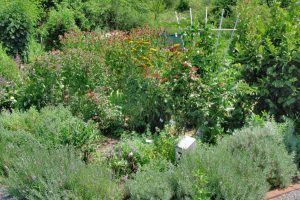
Herb gardens, like the one above at Mercer Educational Gardens, are magnets for beneficial insects offering food, shelter and a place to raise their young. (Photo by Joe Scarlata)
Looking for inspiration? Any garden type or style can become a “good bug” hub. If you’re wondering how to put it all together where you live, try visiting a few insect-friendly gardens like the ones at Mercer Educational Gardens. All of the seven demonstration gardens there — Annual, Butterfly, Cottage, Herb, Native Plant, Perennial and Weed ID– are pesticide free and use Responsible Gardening Principles that support beneficial insects.
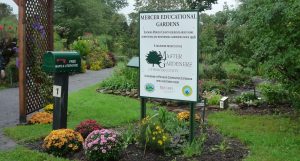
Mercer Educational Gardens is an award-winning site that features seven display gardens, all of which adhere to principles of responsible gardening and pest management. (Photo by Joe Scarlata)
A sheltered life: Beneficial insects need protection during the warm months and shelter during the winter. Be sure there is sufficient vegetation nearby (woods, weeds, mulch) to keep good bugs safe. Hedges and foundation plantings also provide great protection for beneficials. Even garden pathways and borders play an important refuge role by offering soil-dwelling insects–like digger wasps–safe places to raise their young. Although digger wasps may look intimidating, they are nonaggressive and definitely do more good than harm. For instance, the adult wasps pollinate plants by feeding on flower nectar, females prey on grasshoppers and similar pests that might otherwise cause a lot of damage to vegetable and ornamental plants, and by digging holes in the ground, digger wasps help to aerate the soil and improve drainage.
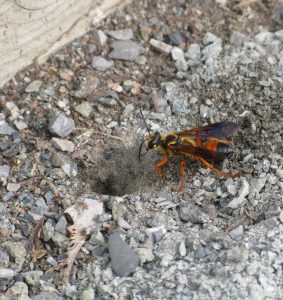
Great golden digger wasps look dangerous, but are beneficial insects that help keep garden pests in check. (Photo by Lan-Jen Tsai)
Friend or Foe? Although most home landscapes support a wide assortment of bugs, it’s important for gardeners to be able to distinguish the “good guys” from the “bad guys.” Being able to identify what that thing buzzing or creeping through the backyard actually is, can be key to getting the full benefit from beneficials.
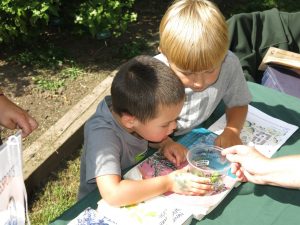
What the heck is that?! Learning to determine which insects are garden pests and which are beneficials is key to creating a balanced backyard ecosystem. (Photo by David Byers)
When you come across an insect you’d like to identify, you can start by consulting a local field guide to insects or call the Master Gardener Helpline.
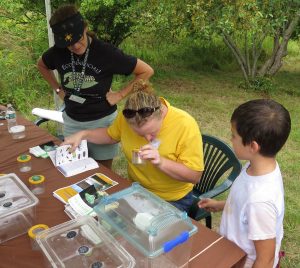
With a trusty field guide in one hand and mystery insect in another, naturalists solve the puzzle of insect identification. (Photo by David Byers)
Master Gardeners can answer all kinds of questions about insects–beneficial and otherwise— and can even tell you the key elements to look at when trying to figure out what type of insect a specimen is.
If you are able to safely capture your mystery bug, you can also bring it by the Rutgers Cooperative Extension office, and talk to a Master Gardener in person.
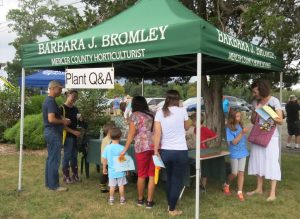
Barbara J. Bromley, Mercer County Horticulturalist, fields questions about bugs at a recent Insect Festival. (Photo by Betty Scarlata)
Kids love bugs! Parents who are considering adding beneficial insects to their yards, should be sure to include the kids in the experience. Children, especially younger ones, seem naturally fascinated with all sorts of creepy crawlers. By encouraging them to take a closer look at insects– as opposed to stepping on them or just saying “Yuck!” — can help kids develop a deeper appreciation for insects and how they benefit the environment. And while not every kid is born a bug lover, showing them that not all insects are harmful, can at least give them a better appreciation for the role insects play in the world we share.
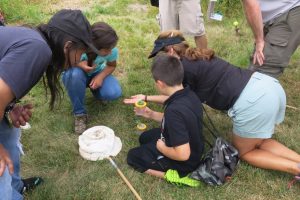
Bugs have a lot to teach us, and can help kids develop important science skills like observation, categorization and identification. (Photo by Betty Scarlata)
Taking part in bug-centric events like Insect Festival can also help fuel kids’ natural curiosity. Activities like tagging Monarchs can be an unforgettable experience for kids and can broaden their knowledge of a wide array of subjects –from the stages of insect metamorphosis—to geography, as they learn the route Monarchs travel on their annual migration to Mexico.
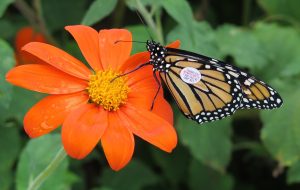
A newly emerged monarch butterfly tagged and ready to set off on it’s winter migration to Mexico.
(Photo by David Byers)
Experiences that feed kid’s curiosity about insects at a young age can inspire a lifelong passion for the natural world.
Teaching kids about the many ways bugs benefit us can help them understand that not all insects are scary or icky.
Focus on fun.
Not every insect-related activity has to be focused on education. Make sure to include insect activities that are purely for fun –like crafts, scavenger hunts and storybooks.

Bugs can be fun! Crafts like these little cardboard bees can keep insect activities from becoming too serious. (Photo by Eunice Wilkinson)
Anything that inspires kids (of any age) to go outside and explore the strange, incredible, and often beautiful insects of New Jersey is a big win for bugs, people and the planet.
Insects are amazing creatures and can inspire kids–of all ages– to unplug, go outside, and explore. (Photo by Betty Scarlata)
References:
